Which greenhouse to choose for a summer residence?

The prototypes of today's greenhouses have been used in European countries since the 16th century, and the first structures made of glass and wood appeared among the English nobility almost 100 years later. Having quickly spread in Russia, greenhouses began to be used for growing exotic fruits and plants. A little later, polyethylene film became widespread. Today, there are many innovations in the choice of material for a greenhouse. About what greenhouses are and what kind of structure is suitable for certain conditions, and will be discussed in this article.

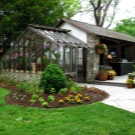
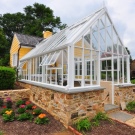
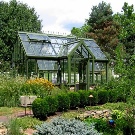


Views
Among all the variety of types of greenhouses, you can find the right option depending on the pricing policy and quality. For example, in terms of time and method of operation, greenhouses are classified into:
Winter
The “speaking” name immediately indicates a paramount feature - due to the compulsory heating (by the energy of the sun, biofuel, technical means), it is possible to grow vegetables, flowers and fruits in such a greenhouse all year round. The building can be either deepened into the ground or be on the surface, but regardless of this, the foundation must be its indispensable attribute.
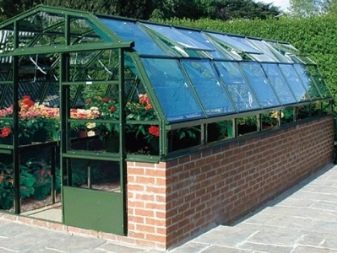
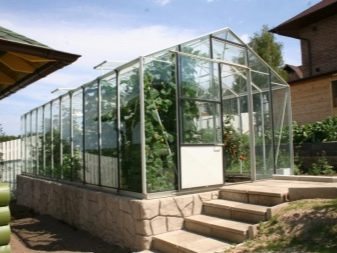
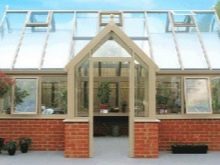
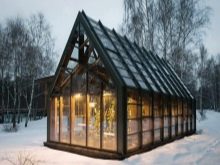

The frame material is wood, brick, PVC or a metal base, and greenhouses are covered with polycarbonate or glazed. But combination options are also possible.
An important aspect of winter buildings is the choice of their location.
- it is preferable to build a greenhouse in length from west to east (in this case, maximum exposure to sunlight is guaranteed);
- free passage to the building;
- fencing from the wind, especially if the natural conditions involve frequent gusts (this can be a structure or hedge about two meters high and at a distance from the greenhouse at least three times the height of the building).
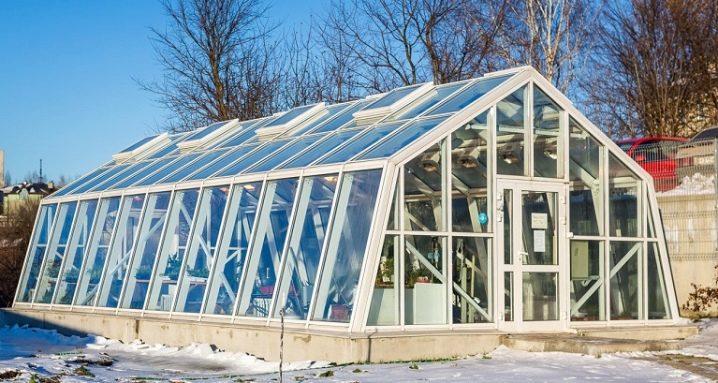
Summer
As a rule, summer greenhouses are used from March to November. The microclimate in the building is provided by the penetration of sunlight, although artificial heating is possible due to the cold snap. The biofuel is compost, humus or manure. The frame is made of wood, metal or plastic pipes. They are considered more economical, since they are covered with an inexpensive film and do not require a massive foundation and insulation. Mainly seedlings or crops that require special care conditions are grown in such greenhouses.
By mobility, greenhouses can be divided into mobile and stationary. The collapsible type of construction allows you to dismantle the structure, which is convenient for those who work in the country only in the warm season. The second variety is optimal for gardeners who visit sites all year round.
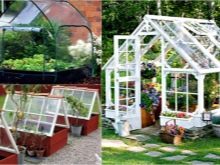
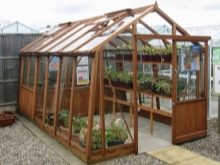

At the location of the structure, there can be free-standing and adjacent to the building. The second option is also often referred to as a wall greenhouse and provides that the wall of the house acts as a load-bearing for the greenhouse. Most often, the building attached to the house is single-pitched, not prefabricated and is used in the cold season, which is why it must be equipped with a heating system.
Botanik
Greenhouses can also vary significantly depending on the model. Thus, the Botanik structures are the only high quality aluminum structures (they do not corrode) from the Russian manufacturer AlumWerk.A feature of the company's concept for more than 10 years is the combination of a high-quality reliable range and a wide range of additional options. The manufacturer focuses on the typical weather conditions for the regions.
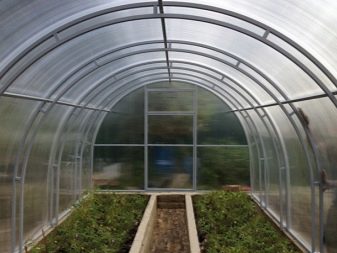
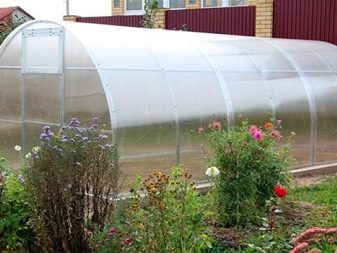
Other distinctive features include:
- quality ventilators of our own production, which guarantee effective ventilation;
- rational compartment type of door that moves to the side, which allows you to increase the usable space for the beds;
- expanded color range for greenhouse frame and sealant;
- high reliability and rigidity of the structure due to the complexity of the cross-section of the profiles and the optimal angle of inclination of the roof;

- durable and effective seal made of special polymers, the effectiveness of which has been tested in the range from -50º to + 50º;
- the material used prevents the glass from rattling, sealing the entire area of the room;
- the possibility of installing additional options due to the modernized bearing profile, which is a slotted structure;
- the possibility of using decorative elements for finishing (ebb tides around the perimeter, skates on the roof, individual deviations);
- advanced fastening system.
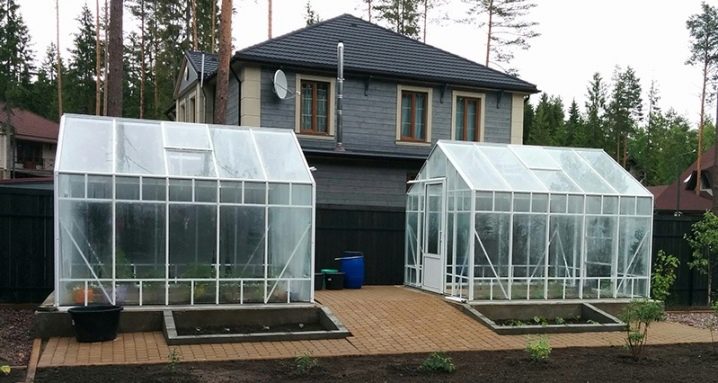
Basic models "Botanik".
- "Mini" - with a width of 2.1 m for compact areas or a small number of cultivated plants. The cost is from 40 thousand rubles.
- "Standard" with an optimal width of 2.8 m for two beds. The cost is from 44 thousand rubles.
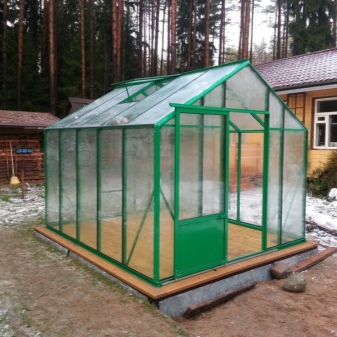
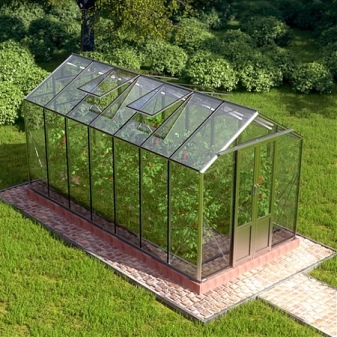
- "Maximum" - with a width of 3.68 m provides ample work space. The cost is from 53 thousand rubles.
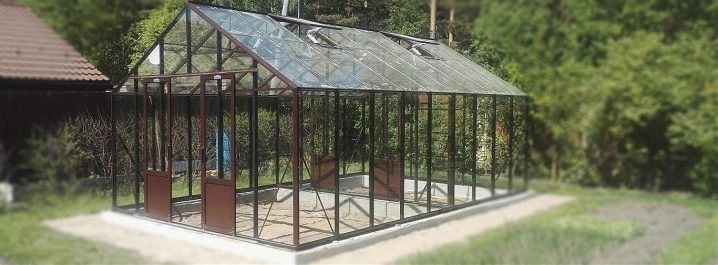
- With vestibule "T" allows you to expand the space due to a convenient and prestigious-looking side entrance. Cost - from 108 thousand rubles.
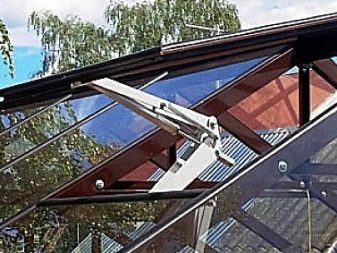
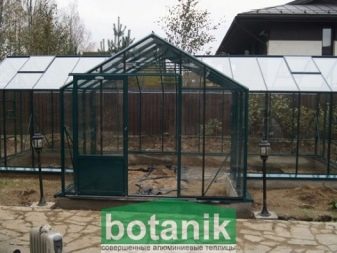
Arrow
Greenhouse "Strelka" is a teardrop-shaped polycarbonate construction of the Moscow manufacturer Volya LLC. Thanks to its shape, it prevents the accumulation of precipitation by rolling it off the roof. Producers of the greenhouse "Dachnaya Strelka" point to its unique properties characteristic only of this design, which has no analogues:
- Additional thermal insulation due to the air formed in the cells of the stiffener joints.
- The foundation is not required.

- The polycarbonate cover protects from the scorching sun rays, but at the same time allows enough light to pass through. In addition, such a material is quite lightweight, but at the same time impact-resistant, which gives an advantage over glass structures. Doesn't need any special care.
- The standard height of 2.5 meters allows you to grow not only low plants.
- Designed for heavy weight.
- Comfortable dimensions (2.6 or 3 meters wide) make it possible to make the most of the entire space to accommodate two beds and a passage.
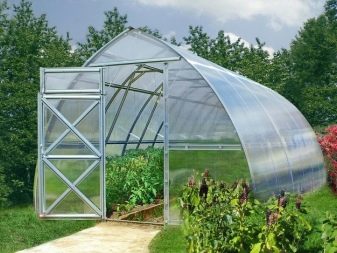
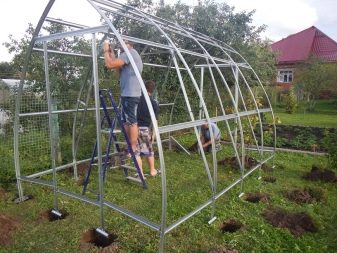
Uralochka
The greenhouse "Uralochka", the main feature of which is the strength of the metal frame with a coating that protects against corrosion, is manufactured by the Neftekamsk Mechanical Plant. The ease of assembly is also a significant advantage.
Other advantages include:
- durability;
- withstands up to 20 kg per m² of precipitation weight (it is important not to forget to take into account the weight of the coating), which allows you to leave the structure intact for the winter;
- reliable sealing;
- ease of care, does not require special processing;
- resistance to changes and maintaining the most comfortable temperature inside the greenhouse.
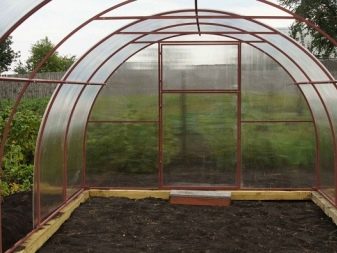
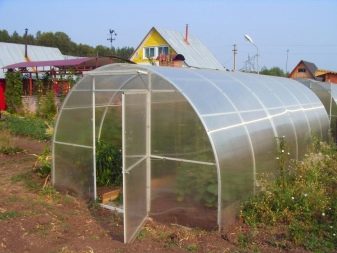
Analyzing user reviews, they note certain shortcomings.
- Behind the ease of assembly lies a common mistake in assembling a greenhouse without using instructions. In this regard, most of the negative responses arise.
- In the northern regions, due to the load from the snow, there are frequent cases of pipe bending. Apparently, the structures are not designed for such weather conditions. To avoid such situations, spacers from a bar are installed.
Having examined the above pros and cons of the greenhouse structure "Uralochka", it is clear that the shortcomings are insignificant and can be easily eliminated, especially if the instructions are used during installation.

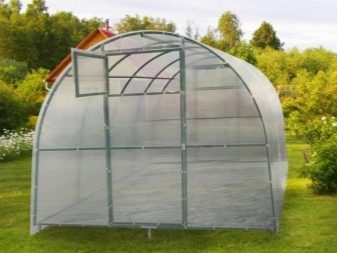
Innovator
Greenhouses "Novator" - new generation constructions from the Russian manufacturer NPO "Innovation" that meet all international standards. Such models allow you to build a building that harmoniously fits into the exterior in the maximum compliance with price and quality, and also simplify the process of maintaining a microclimate.
Innovations among the varieties of the greenhouse.
- The automatic built-in system makes it possible to autonomously irrigate plants and ventilate the greenhouse. This automation allows the season to start earlier than usual.
- Partial "independence" of the greenhouse structure increases the amount of free time that can be devoted to other types of summer cottage work, and even banal rest.
- The structure of the greenhouse makes it possible to grow crops even in regions that are not intended for weather conditions. Reviews suggest that seedlings in such structures grow even faster and more actively.
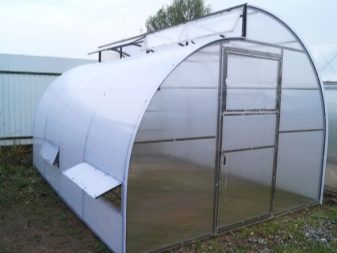
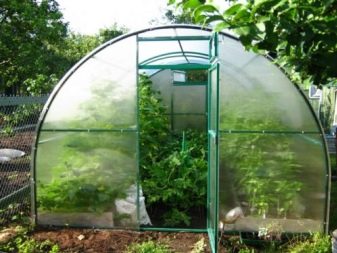
Characteristic advantages of the Novator greenhouse.
- An expanded range of designs and types of designs, which are delivered with a passport and in their original packaging.
- Resistance to wind and precipitation due to the dimensions and pitch of the profile pipe. Uniform distribution of the load is carried out by installing the support arcs clearly perpendicular to the beams. Arcs are placed one meter apart. Therefore, such greenhouses are not afraid of the pressure of snow in winter.
- Ensuring tightness with special seals.
- Two doors with vents are installed in the design of the greenhouse; if necessary, the number of vents can be increased. It is worth noting the presence of built-in locks in the doors.

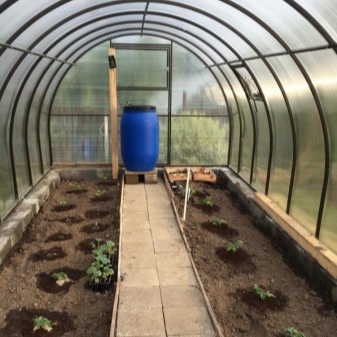
- The ability to grow plants that need to be hung.
- The greenhouse can be fixed on the ground with special "anchors", while eliminating the cost of installing the foundation.
- Ease of installation of the structure, which is remarkable for beginners.
- The ability to divide the space into sections if the plants do not tolerate neighborhoods with each other. For this, special partitions are provided.
- Polycarbonate cover.
- Free height adjustment for different types of crops.
The cost of one of the types of construction of the "Novator" type - mini-greenhouses made of polycarbonate "Kormilets" without additional configurations and a width of 1.5 meters starts from 5,900 rubles.
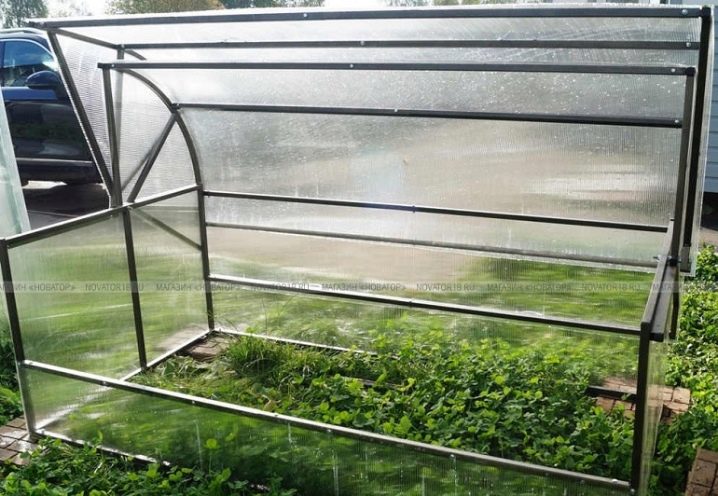
Tsarskaya
Greenhouse "Tsarskaya" is a series of designs of 5 types of different shapes and characteristics. All types can be installed without a foundation. Although its presence, of course, will improve stability and prevent possible subsidence of the structure.
General characteristics.
- The ease of both the design itself and its installation. Without fixing to the foundation, the greenhouse can be easily moved with the help of a couple of people.
- Durability - manufacturers indicate up to 50 years of service with proper care.
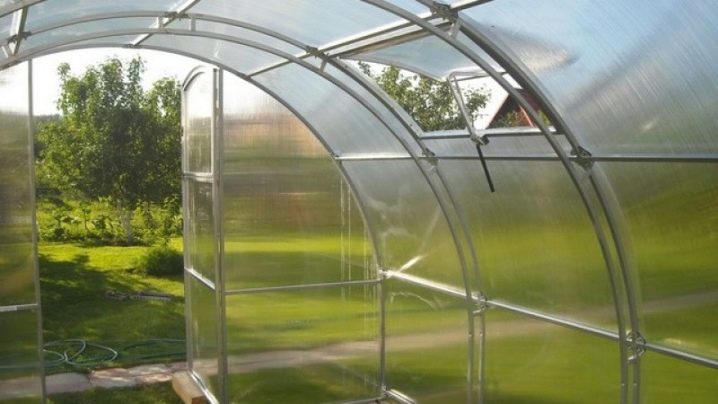
- The use of high-alloy steel of the austenitic class for the manufacture of the frame increases the possible snow load.
- Variations of covering the structure either with polycarbonate material or with a film.
- If necessary, increase in length by means of special inserts.
- Does not require anti-corrosion treatment.
- Most models are equipped with double arches for strength.

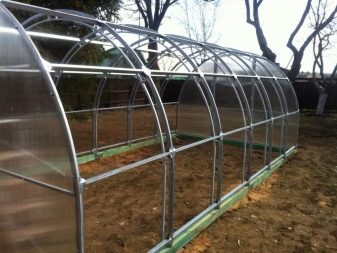
The group of structures "Tsarskaya" represents certain models.
- "Fairy tale" straight-walled with a width of 2.5 to 5 m, a height of 2 m and a length of 2 m. A characteristic feature is two ridge, straight walls and a domed roof. Withstands the load of precipitation up to 750 kg / m².
- "Arrow" has a teardrop shape, width from 2.7 to 3.5 m, height 2.4 m, length from 2 m (multiple of 2). Single and split arcs in the ridge area. Possible load up to 650 kg / m².
- "House" arched shape.The widest model is 3 m, 2.1 m in height, 2 m in length (again, a multiple of 2). The arches are single, but solid and quite strong. The load is less - 450 kg / m².
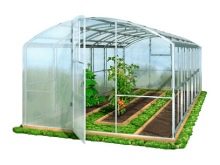
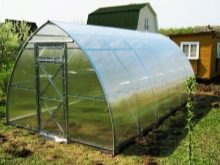
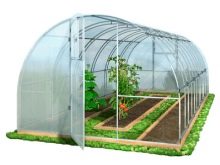
- "Dream" also arched with a double arc, which increases the possible load up to 750 kg / m².
- "Star" of the same shape, it has a width of 2.5 and 3 m, a height of 2.1 m, a length that is a multiple of 2. Due to the double and one-piece arc, the load can be up to 450 kg / m².
Also, among all other models, there are options for smaller and larger designs. These are the "Tsarskaya Malyutka" and "Tsarskaya ZIL" greenhouses. If the parameters of the first are within 2 m in length and in width and it is easy to move, then the second is much more powerful than all of the above. The height of such a structure can be up to 4 m.
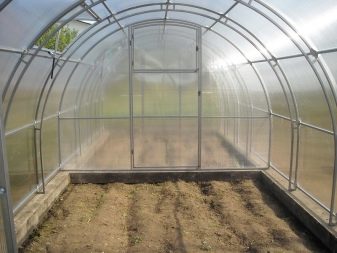
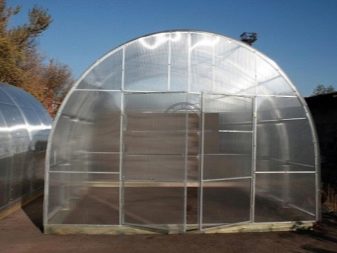
Leader
Greenhouse "Leader" was developed based on the wishes of gardeners.
What is such a construction:
- the dimensions of the building can vary: 3x12 m, 3x10 m, 3x8 m, 3x6 m, 3x4 m, and 2 m in height;
- the material for the frame is a profile steel pipe 25x25x1.5 mm and cellular polycarbonate with a thickness of 4 or 6 mm is used;
- it is recommended to install on a foundation made of masonry, concrete, channel or wooden beams;
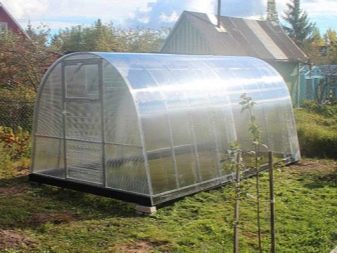

- in the basic package, you can optionally add upper modular vents or partitions for dividing the frame into two parts;
- in windy weather, special holders are especially practical;
- doorways as standard for a 3x4 m frame - one, and for large greenhouse parameters, two modules are provided.
Dirt from the surface of the greenhouse is removed exclusively with a cotton cloth, using detergents and water. Otherwise, dry wiping will damage the protective layer of the coating. Detergents in their composition should not contain chlorine, ammonia and caustic alkali. Car paint should be used on the damaged area of the coating to avoid metal corrosion.
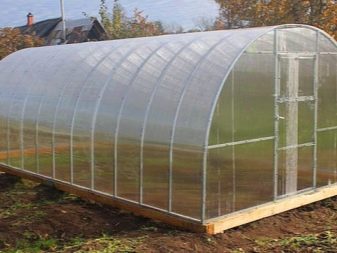

Dismantling for the winter is not carried out if it is known that the height of the snow cover near the structure will not exceed more than half a meter, and on top of the greenhouse on cellular polycarbonate - no more than 10 cm.In other conditions, it will be necessary to carry out regular sweeping of snow, otherwise it can lead to deformation or even destruction of the frame and coating. It is worth remembering that the snow load of the structure is no more than 20 kg / m² with a wind speed of up to 15 m / s.
A significant advantage of Leader greenhouses is the possibility of easy transportation.
Largusha
Greenhouse "Largusha" from the manufacturer "Largo Enterprise" is elementary in installation, as it has an optimal number of parts and does not need to be installed on the foundation.
Other design characteristics:
- greenhouse dimensions - 3x6x2 m or 3x4x2 m;

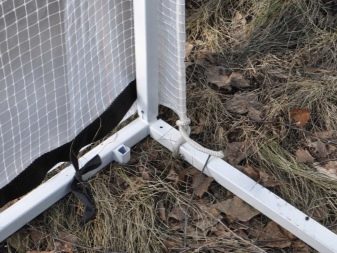
- durable polymer coating on a steel profile pipe as a frame;
- the lack of a foundation is compensated by special reliable lugs;
- tightness of all junctions;
- the presence of two doors and two vents;
- use of a strong reinforced film for a canopy that can withstand temperature changes from -50Cº to + 80Cº;
The cost of the smaller model of Largusha greenhouses is from 7 thousand, the larger one is from 16 thousand rubles.
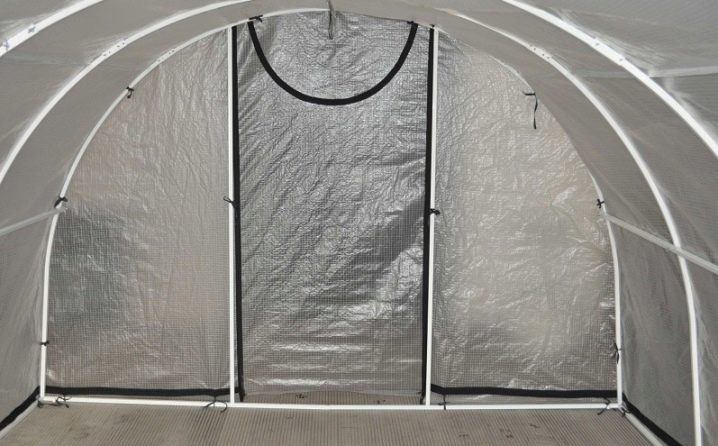
Orange
Greenhouse "Orange" is an easy-to-install, but at the same time reliable design, which has been in demand for more than 5 years. The shape of the greenhouse is an oblong dome with transverse arches. A significant space for growing seedlings is associated with the parameters of the structure - 4x3, 6x3, 8x3, 10x3 and a little more than 2 m in height.
One of the most important points when choosing a greenhouse is the reliability of the frame. The structures "Orange" are distinguished by high-quality load-bearing coatings made of Cherepovets steel with a polycarbonate coating. The thickness of the zinc layer on the metal is twice that of other manufacturers. The profile is stiffened by the closed crimp seam of the pipe.
The second stiffening rib is the arched structure on the reverse side of the profile.
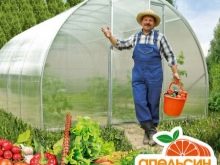
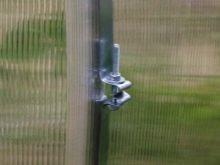
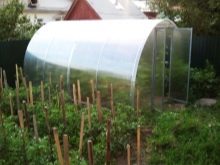
A significant feature of the device is the door module, which consists of two leaves. At the locations of doors and vents, a special reinforcement is installed to prevent rapid wear.
The polycarbonate coating does not require any special maintenance or treatment.
It is possible to lengthen the greenhouse with inserts by 2 m. The average cost of a greenhouse "Orange" with the smallest polycarbonate starts at 16 thousand rubles.

Eco
Greenhouses "Eco" from the most popular manufacturer "EcoTeplitsa" guarantee the most efficient cultivation of environmentally friendly products due to natural light, water, temperature and natural fertilizers. A design feature is the use of a special technology without welding seams, which protects the metal from corrosion.
Other characteristics of Eco greenhouses include:
- long service life (almost 2 times) in comparison with similar structures;
- snow load - up to 450 kg / m²;
- polycarbonate with UV protection;
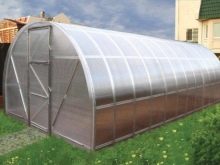
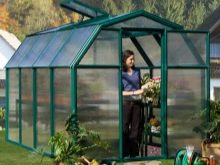
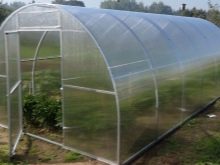
- spacious doorways and vents;
- combination of acceptable cost with quality;
- easy installation.
Advantages and disadvantages
Severe frosts in spring or autumn, rainy summers, harsh and long winters negatively affect plantings. Therefore, the obvious advantage of greenhouse structures is, of course, the protection of the crop from the variability of weather conditions.
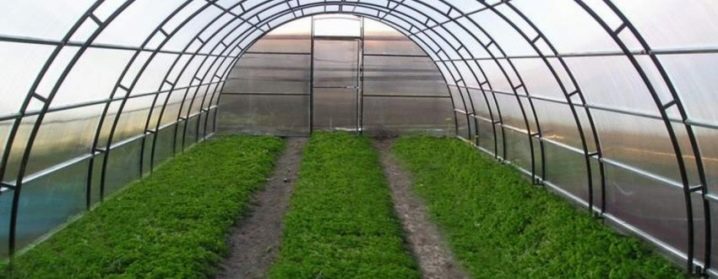
In addition, today there is a huge selection of ready-made greenhouse options that are elementary in installation and do not require the participation of specialists. It is easier, because you do not have to independently make the same arcs, rigging, slipways and pipe benders. However, there are drawbacks in such structures.
Traditionally, greenhouses are arched and covered with honeycomb polycarbonate. This choice of form is not justified by the optimal design, but by the convenience of manufacturing for the manufacturer. For this, a sheet of 6 m is taken and bent into a semicircle. Thus, with a width of 3.8 m, the height of the greenhouse turns out to be 1.9 m, which is not so much, therefore, the greenhouse often has to be installed on a high base.
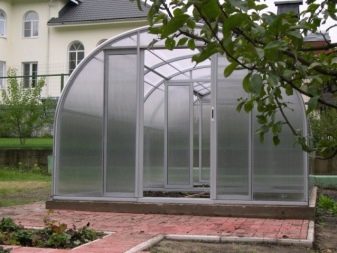
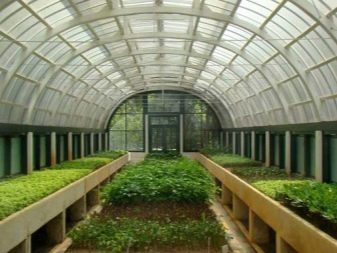
The reflective property of polycarbonate affects the loss of essential sunlight. The arched structure in this matter is inferior to greenhouses with flat surfaces that are focused on the perception of light. This shape of the greenhouse reflects a much greater amount of heat, which is why such structures are characterized by a significant shine in the sun, but in places where there is a reflection, the required amount of light does not get inside.
Another significant disadvantage of ready-made polycarbonate greenhouses is complete transparency on both sides, as a result of which the heat that comes from the south side simply comes out from the other. In homemade constructions, the sun's rays remain inside the greenhouse, heading towards the plants.

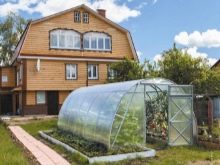
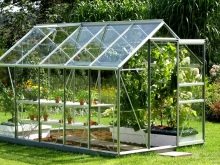
Forms
Greenhouse constructions in shape have the following varieties:
- single or gable with vertical walls;
- arched;
- polygonal;
- greenhouse pyramid;
- domed.
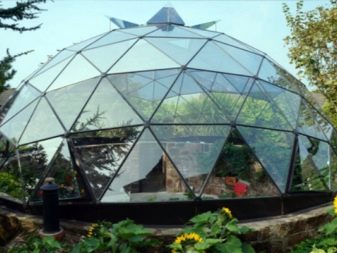
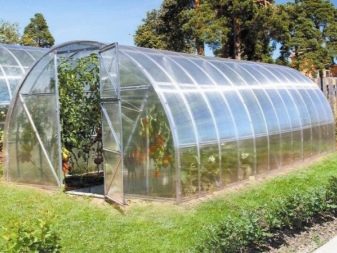
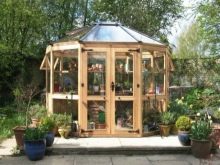
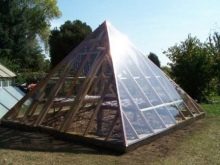
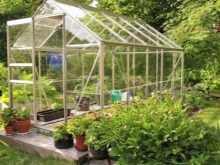
Single-pitch and gable
One of the most common designs are single-slope and gable greenhouses. The former can be built right next to the house or any outbuilding so that one of the walls of the house and the greenhouse are aligned. This shape allows you to reduce the cost of the frame of the structure and on thermal insulation, since the load-bearing wall of the greenhouse, which is also the wall of the house, whether it is made of brick, wood or concrete, in any case transmits less heat than film or glass. The disadvantages of the structure can be the accumulation of precipitation due to the shape of the structure and the reduction in lighting. Therefore, when installing, it is important to take into account the position of the greenhouse relative to the sunny side, excluding the option of placing it on the north side. A single-pitched greenhouse with a removable roof is also common, allowing, if necessary, to remove individual parts of the roof.
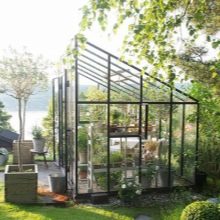
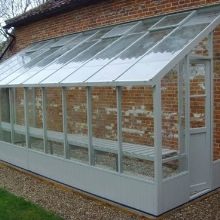
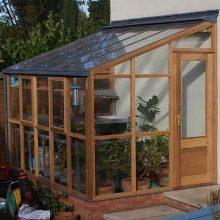
An example of a pitched roof is Ivanov's Vegetarian, which was developed by a school physics teacher. The slope of such a roof is about 20º, and the blank rear wall acts as a reflective screen.
The gable greenhouse consists of two vertical and two end wallsconnected by inclined planes. Such a square or rectangular design is called a "house". It is worth noting the significant weight of the possible load on the structure. Also, the advantages are the ease of installation of the ventilation system and the suitability for growing rather tall plants throughout the greenhouse area. As a frame material, you can use both wood, metal and brick.
The complexity of installation and significant material costs are the main disadvantages of the gable design.
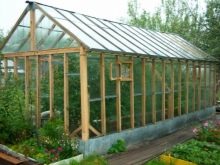

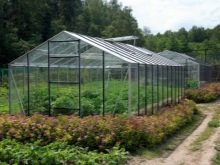
Arched
An arched greenhouse is the most economical option. And the whole thing is in the form of the structure, which does without sharp corners, and therefore the amount of covering material is significantly reduced. Thanks to this, arched greenhouses are famous for their longevity. Better wind resistance is also an important feature. Most often, such structures are acquired already in finished form, since independent construction is quite laborious.
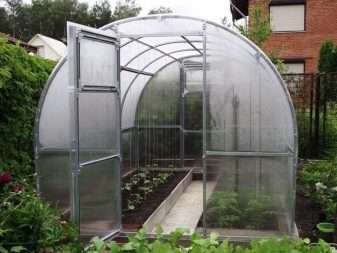
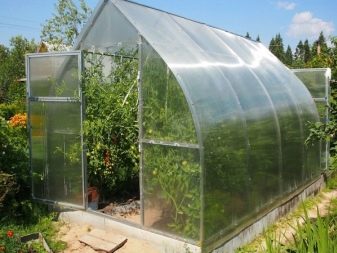
Disadvantages:
- Possible cracks due to snow load. This form pours snow down much worse and often has to be cleaned.
- Limited placement of shelves and racks indoors due to the shape of the structure.
- Difficulty in accessing the outer rows.
One of the varieties of the arched structure is the teardrop shape. It is a cross between a gable and an arched greenhouse. Due to the connection of the roof slopes at an acute angle, the structure is reliable, and precipitation does not linger on it.
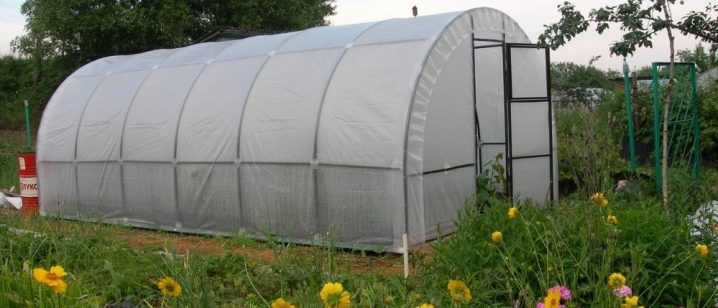
Polygonal
Polygonal (often octahedral) the design is not used so often, despite its significant advantages:
- attractive and effective look;
- high light transmission;
- strength.
The disadvantages are the complexity of installation and high costs both for material and for the ventilation system, which will require the development of a drawing. In addition, it is quite difficult to maintain a stable temperature.
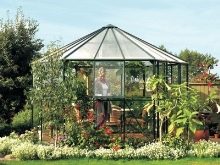
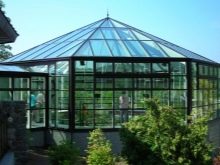
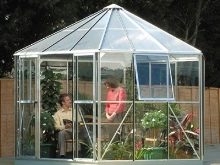
The design of such a greenhouse was created to improve the diffusion of light in the glass structure.
Greenhouse pyramid
The pyramid greenhouse is quite rare and, rather, in experimental or design ideas. The originality of the design is combined with the laboriousness of installation.

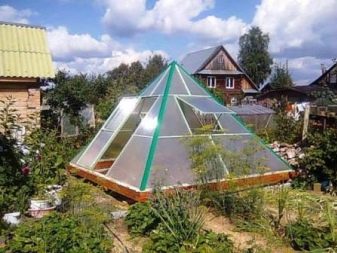
Dome
An innovation is the dome model of the greenhouse. It is a structure with interconnected triangular elements.
In addition to the unusual appearance, the advantages of such a model are:
- diffuses light much better;
- heat resistant;
- does not need supports and foundation, since the coating itself is self-supporting;
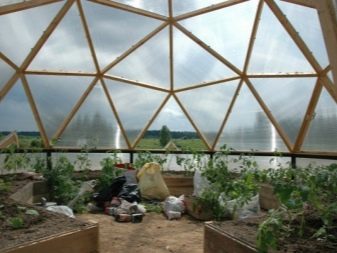
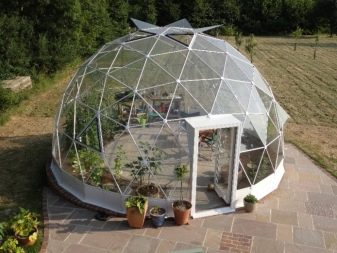
- wind resistance due to aerodynamic shape and wide base;
- practical arrangement of the beds;
- a high round greenhouse allows you to be in it at full height;
- the ability to raise the beds higher, which is especially important for older gardeners;
- insignificant weight.
The intricacy of installation and the problem of operating the entire space are serious drawbacks of the round design. Reviews speak about the difficulties of the passage to the greenhouse with a wheelbarrow.
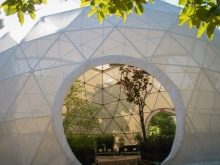
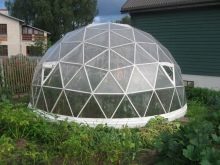

Dimensions (edit)
Greenhouse designs come in a variety of shapes and sizes.
When choosing an option for a vegetable garden, you should focus on the following points:
- total area of the site;
- what kind of crop will be grown and its maximum height;
- comfortable placement at full human height;
- purpose of the building: industrial economy or for personal use;
- available costs for construction.
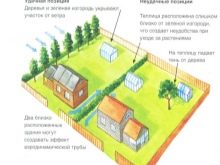
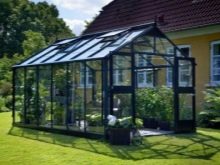

Greenhouse parameters are determined by 3 values: width, height and length.
The primary indicator is the width. Both the convenience of those who will work in the greenhouse and the comfort of the plants themselves depend on this value. Moreover, when calculating, it is imperative to take into account the width of the door, the average of which is 57-62 cm. ...
Thus, adding up all the indicators, the minimum width of the greenhouse structure will be:
57 + 98 + 60 = 215 cm
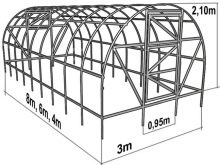
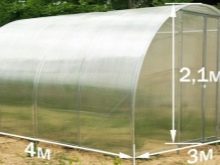
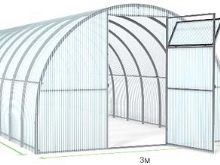
However, experts recommend adding an additional 30 cm to these parameters, which ultimately allows you to display the average width parameters of 245 cm.
The next indicator is the length of the greenhouse. If the choice fell on a ready-made structure, then the best option would be a length equal to the polycarbonate sheet from which the structure is being erected - 200-210 cm. 10-15 cm of the walls of the greenhouse are added to this parameter. When planting plants in shelving pallets, it will be more efficient to build a short greenhouse to maintain an optimal climate.
The height of the greenhouse depends on how much materials are available, if the construction will be carried out with his own hands without the involvement of third-party companies. Optimally comfortable parameters are considered to be an interval of 180-200 cm. In the event that even if the height of the plants themselves is up to 50 cm, in such conditions you will not have to bend over.
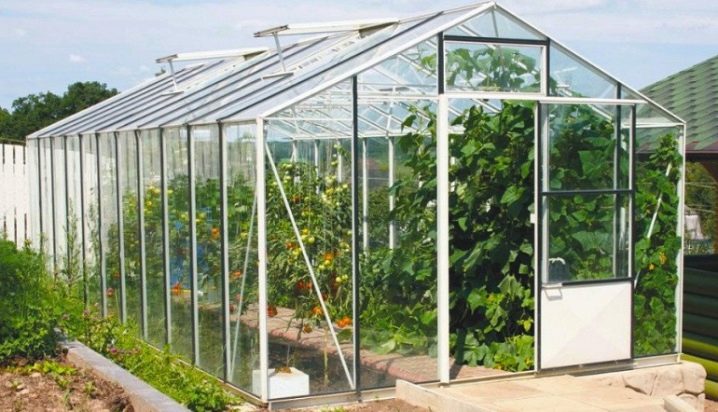
It is worth remembering that large structures also require significant costs not only for construction, but also for heating. In addition, the kits of some ready-made greenhouses include special enlargers, if suddenly the design parameters become too small.
Materials (edit)
In order to withstand weather conditions such as wind, snow, rain and temperature extremes, greenhouse frames must be built of very strong material and covered with a high-quality coating.
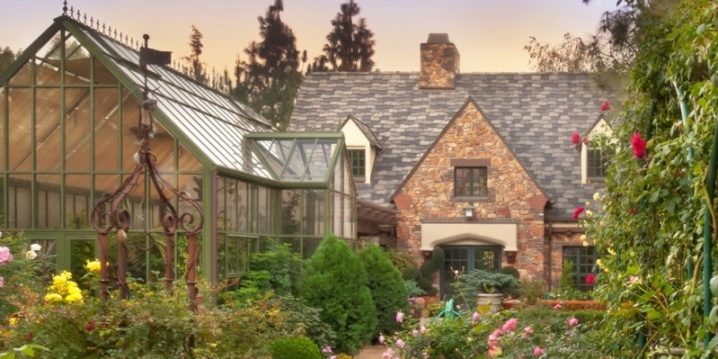
Wood
The first frames were made of wood. Due to its reasonable cost and ease of processing, this material was quite popular. In addition, wooden buildings have low thermal conductivity. But the significant disadvantages of such structures are the high risk of fire and not a long service life. Although it is possible to use different antiseptics and choose less whimsical wood (larch, spruce, pine, etc.)
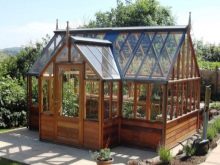

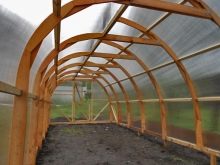
Metal
Metal frames have a lot of positive reviews. Galvanized or painted construction will last a long time and is easy to install. However, such advantages hide a predisposition to corrosion and high thermal conductivity.
Material such as aluminum does not corrode. Lightness, durability and strength are second only to the high cost and all the same thermal conductivity characteristic of metal.
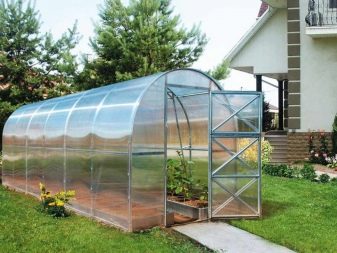
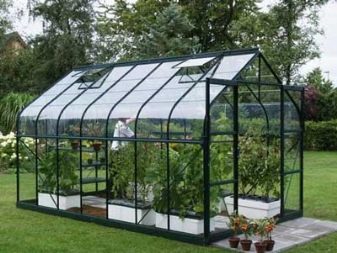
Corrosion of fiberglass reinforcement is not threatened. A frame made of such a material is lightweight and requires minimal construction time (depending on the parameters - about an hour). Despite the flexibility of the reinforcement, the structure is reliable and durable. Does not require a foundation.
Composite reinforcement with a diameter of 6 mm to 8 mm is chosen as a building material for a greenhouse.
The following materials are used to cover greenhouses:
- film;
- glass;
- polycarbonate.
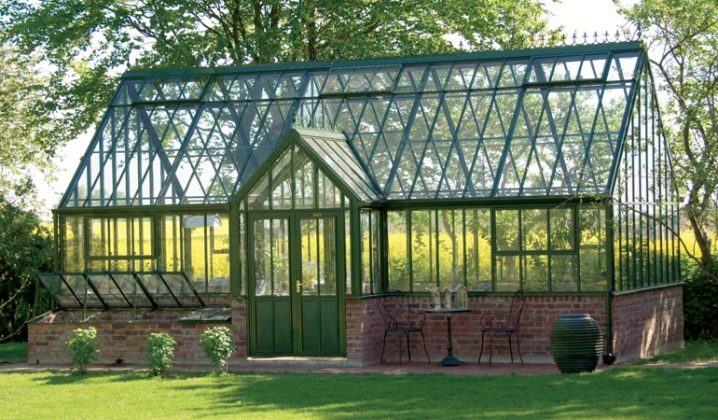
Film
Of course, the most affordable in terms of cost and self-installation is the film. A roll of greenhouse cover 100 m long and 4 m wide will cost up to 5,000 rubles.
Among the benefits are also noted:
- lightness and mobility;
- optional foundation;
- transmits the optimal amount of ultraviolet radiation.
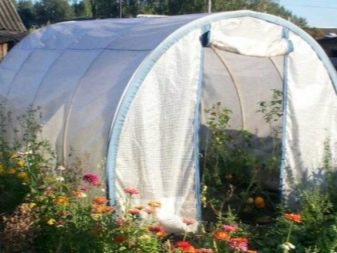
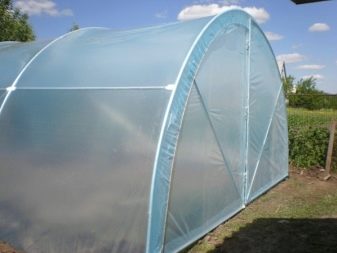
Unfortunately, this is where the pros end, giving way to rather significant disadvantages:
- the film is unreliable and quickly damaged;
- Colds negatively affect this material - after winter, the greenhouse often has to be tightened again.
However, if these shortcomings are not scary, then to cover the greenhouse with polyethylene material you will need:
- directly the film itself;
- slats;
- screwdriver;
- the stapler is furniture.

Glass
Glass structures are more durable and, on the one hand, stronger than film, but they are subject to both physical influences and temperature differences in the greenhouse itself and outside it. Overheating inside the building is possible during hot seasons. The minimum glass thickness is 4 mm. And by improving the lighting of the greenhouse due to the large frames, the heating costs also increase. In addition, the transportation of such a fragile coating itself is quite laborious, not to mention glazing. After all, the load from the weight of the glass must correspond to the parameters of the frame.

Among the positive aspects of such material are:
- optimal thermal insulation;
- high light transmittance.
A set of glasses 4 mm thick for a structure with an area of 12.6 m², including accessories for a window, doors and partitions, will cost 21 thousand rubles.
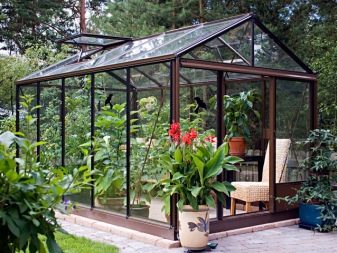
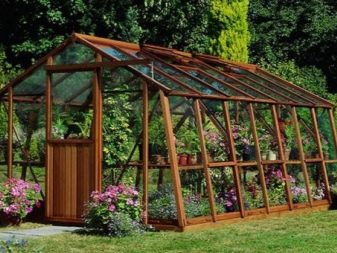
Polycarbonate
Today, an innovative material is polycarbonate. It is a fairly hard, colorless plastic that can even be re-melted several times.
Polycarbonate greenhouses have clear advantages over the above coatings:
- it is a lightweight and flexible material;
- pleasant appearance;
- reliability - they are almost 200 times stronger than glass;
- not affected by temperature changes and weather conditions;
- fire resistant;


- perfectly keep warm:
- lighter than glass 16 times;
- light transmittance up to 86% and light scattering over the entire area of the greenhouse;
- reliable sound insulation;
- durability;
- not subject to physical influences;
- protected from UV rays.

Among the negative qualities, if they can be called that, we can note:
- mandatory installation on the foundation;
- due to the hollow structure, they are susceptible to the ingress of dirt, which deteriorates the light transmission function and appearance;
- with an incorrect arrangement of sheets (UV protection inside), the operating time is reduced.
However, taking into account all these features during installation, it is quite possible to do without damage and operate a polycarbonate greenhouse for a long time.
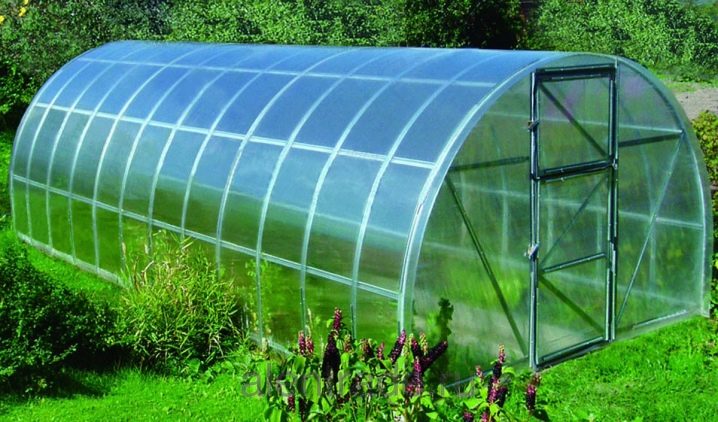
There are several varieties of such material on the modern market:
- cheaper Chinese products of low quality;
- strong and durable European polycarbonate, which, of course, differs in cost.
The price of cellular polycarbonate with a thickness of 4 mm - from 148 rubles per m².
Equipment
Innovative technologies today make it possible to equip a greenhouse with the latest technology, making the work of gardeners as easy as possible. This not only saves a lot of hassle, but also increases yields by 15-30%.
The following systems are involved in creating optimal conditions in the greenhouse:
- heating;
- glaze;
- lighting;
- ventilation.
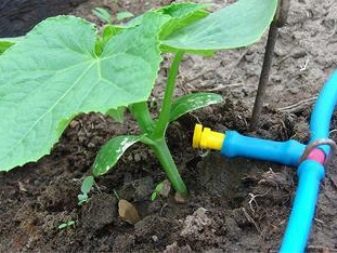

The fundamental difference between a greenhouse and a greenhouse is the presence of an artificial heating system.
The principle of a heating system can be based on the following options:
- The electrical equipment is a set of an electric heater, an air heater and a variety of convection systems. High energy costs are hidden behind the high efficiency of this method of heating the greenhouse. Therefore, in such cases, in order to save money, autonomous power sources are installed, such as a solar vacuum collector.
- Aerial equipment is considered a professional installation. This is a standard ventilation system that is installed in conjunction with the installation of a greenhouse structure. In this case, air enters both the upper and lower parts of the structure, thereby protecting the landings from thermal burns.
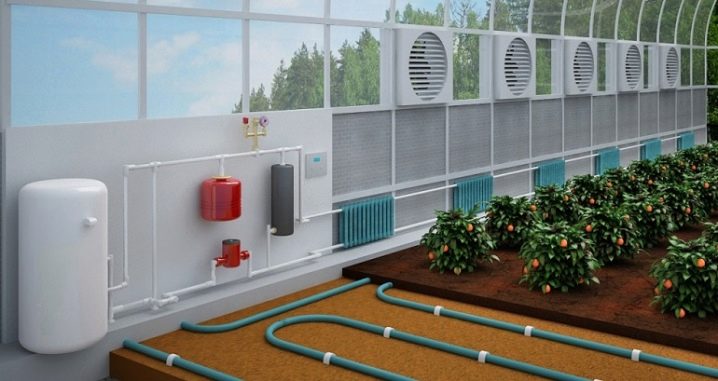
- Infrared equipment significantly reduces electricity costs, while the heated air masses are distributed as evenly as possible.Such devices are mounted around the entire perimeter of the greenhouse, thereby reducing the heat loss coefficient.
- Gas equipment is an ideal value for money. With this heating method, a gas generator is used, which supplies warm air heated inside to a specific area of the structure.
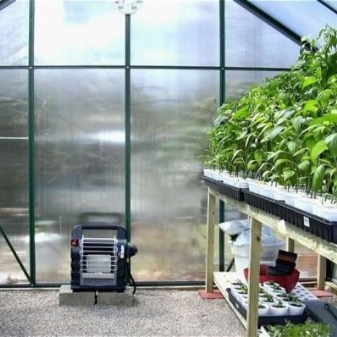
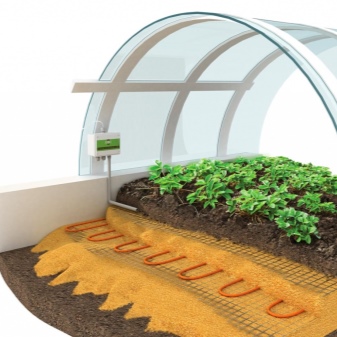
A high-quality irrigation system for the beds is also important.
There are several types of ready-made kits.
- Subsoil watering it is considered the most practical when it is possible to use a well, but this option is very laborious and often does not justify itself. For this method, an intra-well system is equipped using any water container, a watering can, a hose and a measure. The depth of the system is influenced by the variety of culture.
- Drip irrigation provides for the use of pipes and special droppers. It is more advisable to choose polyethylene or polypropylene pipes, although a metal pipeline is also possible. The design is based on a centralized water supply system or a well with the obligatory use of a pump. Often such a system is used when irrigating beds in the open field.
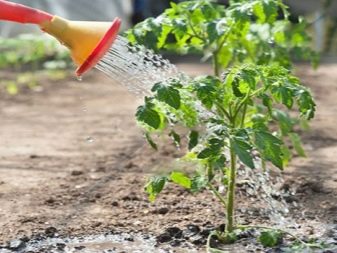
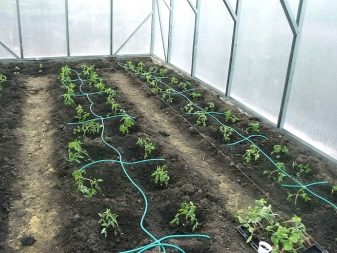
- Automatic option watering plants is most often used on an industrial scale. It is a complex design of a large number of pipes, hoses, drippers and an automatic water supply control panel.
- The so-called semi-automatic version irrigation. It is based on the use of plastic bottles. The undoubted advantage of such a system is the minimum cost and short setup time. The standard volume of bottles used is 1-2 liters, on average it is enough for 2-3 days, depending on weather conditions and the needs of plants for moisture.
To install such a system, you will need:
- directly the plastic bottles themselves;
- scissors;
- needle;
- a piece of gauze, cotton fabric or nylon;
- shovel.
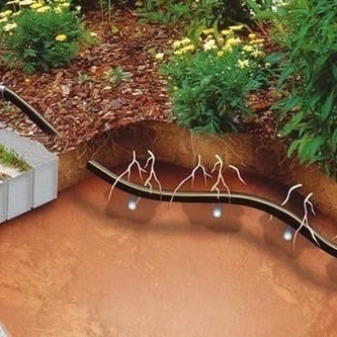
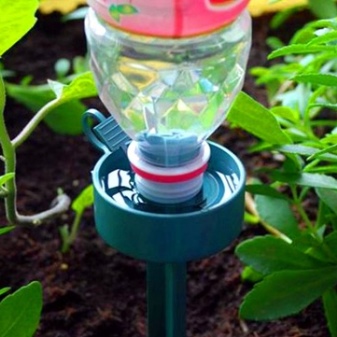
An ideal microclimate in a greenhouse structure will create a fogger, regardless of whether artificial or natural ventilation is installed. Humidification occurs by spraying water under pressure up to 100 atmospheres. The water particles formed by the nozzles, not exceeding 10 microns in diameter, hang in the air, thereby creating a fog effect.
Such systems have the advantage over standard irrigation systems in that they are ideal for sensitive crops, improving seed germination and stimulating growth. In addition, performance is ensured regardless of the season.

Pros of a fogger:
- minimization of costs for water and electricity;
- increasing the productivity of the greenhouse structure;
- maintaining an optimal level of humidity;
- acceleration of plant growth;
- reducing the need for watering;
- stable microclimate;
- minimizes human work.

Light plays a key role in the growing process of plants. That is why the most illuminated places are chosen during the construction of the greenhouse. However, even with an ideal location, an artificial lighting system is indispensable to improve yields. This is especially true for areas with short daylight hours.
Several devices serve as a material to compensate for the lack of light.
- Standard incandescent lamps are allowed only when growing greenhouse greens and are strictly prohibited for seedlings of cucumbers and tomatoes. It's all about the infrared type of radiation, which is dangerous by deformation and even burns during prolonged interaction with plants. The recommended time of use is no more than 15 hours.
- Mercury lamps have significant heating and time limitation of use. In addition, a large amount of ultraviolet radiation is emitted in the near propagation spectrum.
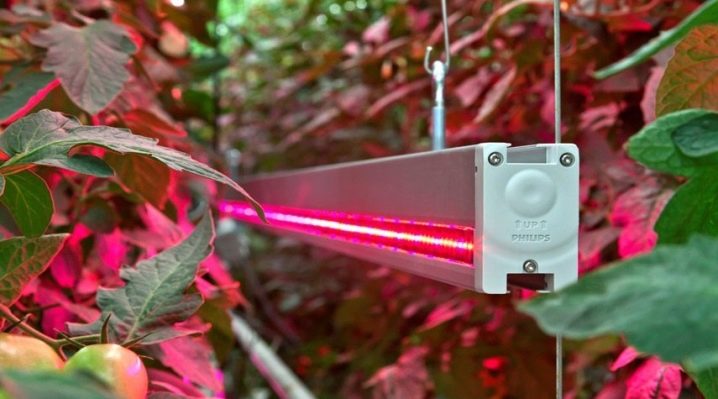
- The most common fluorescent lighting devices for greenhouses. They are renowned for their economy and durability.True, the heat transfer parameters are not acceptable enough.
- Competitive sodium lamps make up for the lack of heat dissipation. Their yellow-orange monochromatic light field has a beneficial effect on the development of planted plants in the greenhouse. Quite an economical option.
- One of the most expensive options is LED lighting. Opinions about arranging such devices in a greenhouse are very different, since due to the directivity of the radiation, a lot of lighting points are required.
- Metal halide lamps are the best option. With their durability, they are quite small. In addition, their significant plus is in indicators corresponding to natural light.
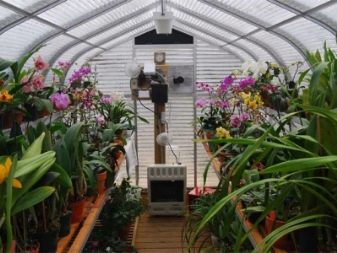
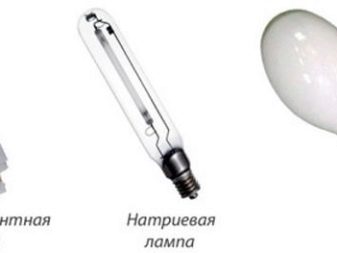
It is quite obvious that for a full-fledged air exchange in the greenhouse, it is not enough just to install several vents, especially if the structure is quite large. It is desirable to arrange a forced ventilation system. The hydraulic cylinder will automate the ventilation process.
To install you will need:
- vents from all ends of the greenhouse and on the roof;
- holes on top for ventilation;
- special sensors;
- automatic control panel;
- circulating fans.

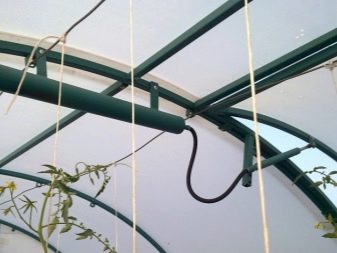
The system will maintain the optimum temperature, if necessary, will open and close the vents, ensure the circulation of fresh air. The principle of operation is based on the movement of the piston due to the expansion of the liquid when exposed to heat. When the temperature drops, the hydraulic cylinder is activated by the initial position of the liquid, closing the window. Of course, the cost of such a device is high, but these costs are quite reasonable.
Automotive oil or flushing compound is suitable as a fluid in the hydraulic cylinder.
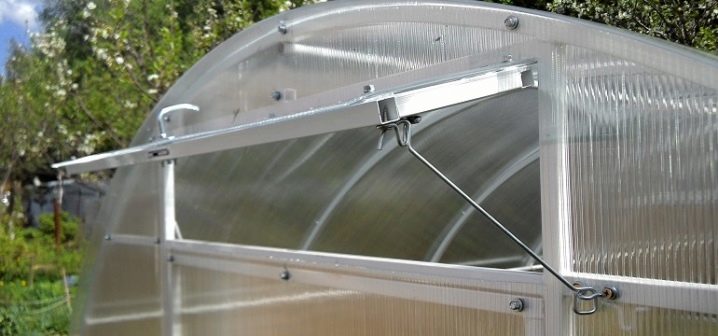
Manufacturers
Even at first glance, one can notice a tangible contrast between the domestic design of the greenhouse, produced at the plant, and the Chinese attempt at plagiarism. Low-quality greenhouse base is very thin and easy to bend.
To select quality products, we present you a rating of popular modern Russian manufacturers.
Volia is a company from the city of Dubna. Reviews indicate such high-quality models of her as "Dachnaya-Strelka", "Dvushka" and "Optima". Branches are located in Moscow, St. Petersburg, Nizhny Novgorod, Saratov, Samara, Sverdlovsk regions.
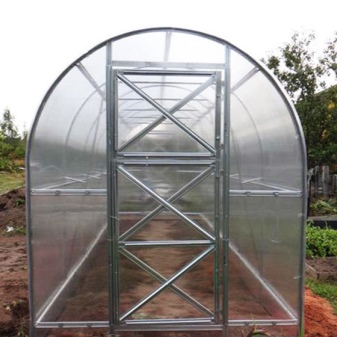
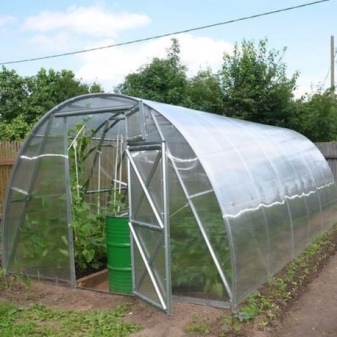
The reliable design is offered by the manufacturer from the capital "New Forms". The modern popular collection of models is represented by the models "Bogatyr", "Fairy Tale", "Kremlin Lux" and "Star".
The manufacturer from Nizhniy Novgorod, Urozhay Trading House, is known throughout Russia. The best models are "Urozhay-PC" and "Urozhay Elite-Absolute".
The Neftekamsk plant is famous for the quality and reliability of the Uralochka greenhouse structures. The manufacturer's branches are represented in most of the largest cities in Russia.
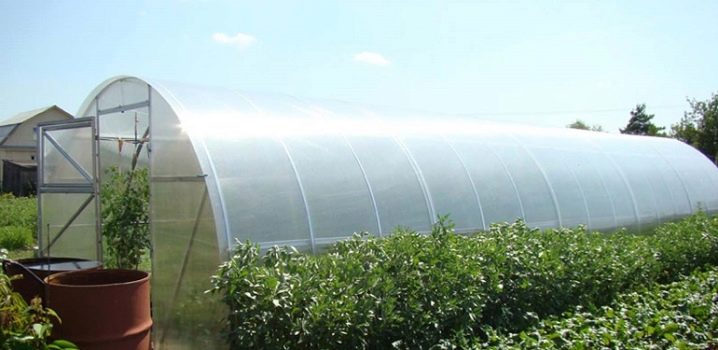
Selection Tips
When choosing a greenhouse structure, it is worth paying attention not only to the manufacturer, but also to some factors.
- It is worth deciding whether to build a greenhouse yourself or choose ready-made models. Giving priority to the second option, it is important to check the complete set of the structure. It should include not only the frame and coating material, but also seals, doors and vents.
- Decide what goals are pursued during the construction of such a building: it will be the production volume of growing flowers or a simple household for the cultivation of fresh fruits and vegetables, since the size and even the shape of the greenhouse depends on this. For example, the best floral designs are built with pitched roofs and a lower south side.
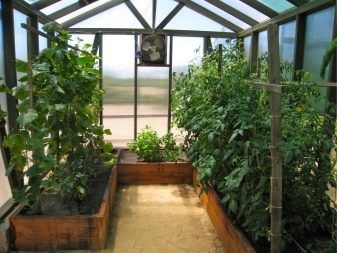
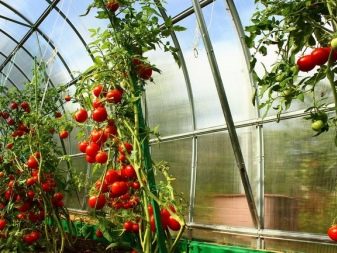
- The next step is to determine which plants will be in the beds, given the fact that not all crops can get along with each other. So, beds of peppers and cucumbers will comfortably coexist, but next to tomatoes, planting both is undesirable.
- Next, you should pay attention to the choice of material for covering the frame. In addition, the foundation cannot be ignored, although the foundation of the greenhouse is necessary and not in all cases.
- And, of course, you need to decide what functionality the future design will have - a ventilation system, automatic irrigation and heating.
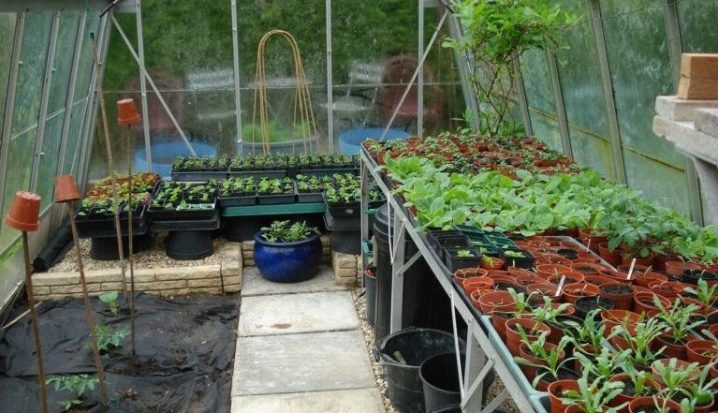
How to assemble by yourself?
DIY greenhouse installation instructions are quite simple:
- clearing a place for a foundation and installing a wooden screed;
- installation of the base;
- you need to start creating a frame from the front side;
- door and window frames are hinged;
- end elements are equipped with holes of 30-40 cm;
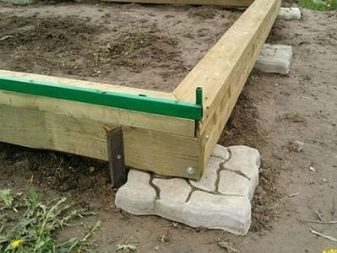
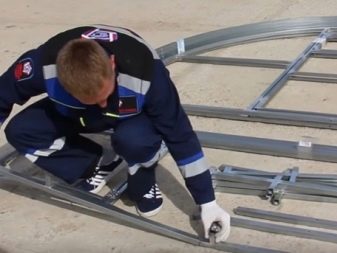
- the sheathing also starts from the end side - the polycarbonate sheet is installed so that the edge is flush with the left vertical end post. For fastening, a self-tapping screw with a rubberized cap is used;
- do not forget about the arrangement of ventilation vents, which are most often located in the door;
- installation of fittings;
- collecting the second end part of the greenhouse;
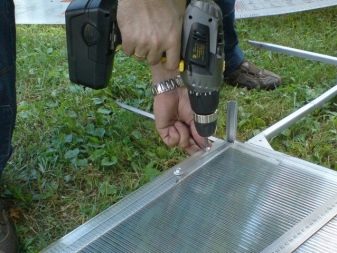
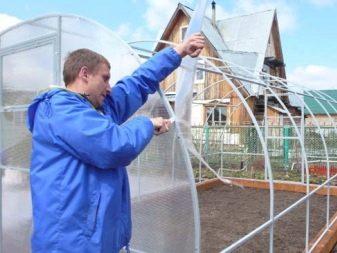
- installation of arcs for jumpers, measuring a place for them from the middle of the arc in 90 cm increments;
- fitting of cross elements on arcs and installation of the latter with jumpers;
- fastening the ends to the greenhouse box with T-shaped elements;
- then you need to make holes in the arcs every 40 cm;
- covering the rest of the greenhouse.
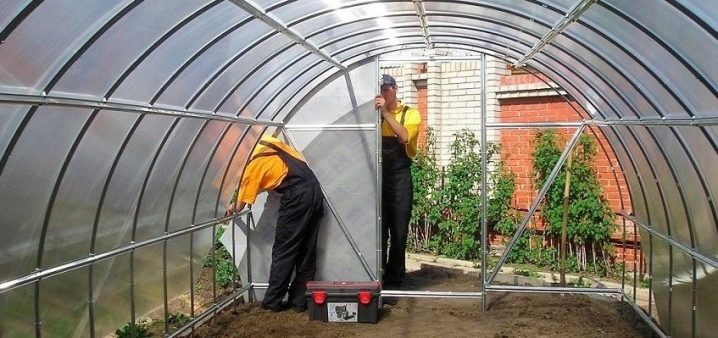
Successful options
- A typical example of a polycarbonate greenhouse construction.
- Unusual multilevel slopes will fit brightly into the exterior of the site.
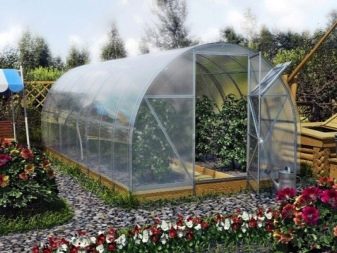

- Beautiful options with transparent polycarbonate.
- Teardrop model of a greenhouse.
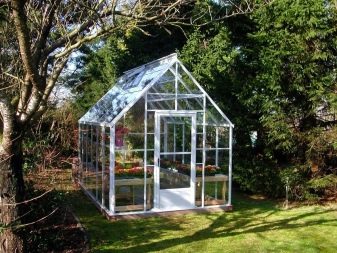
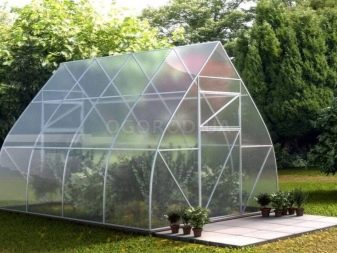
- Structures from window frames look extraordinary.
- The most comfortable sliding roof models.
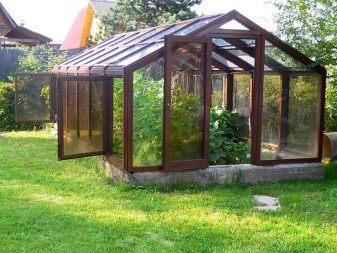
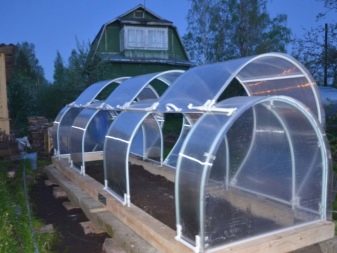
- Large-scale year-round buildings.
- New industrial developments.
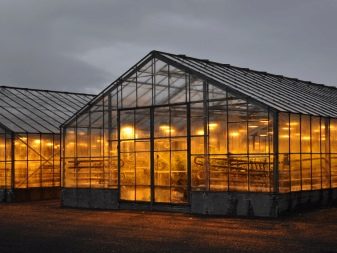
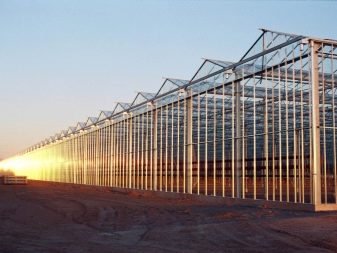
- Mobile greenhouse car.
- Attached version of a lean-to building.
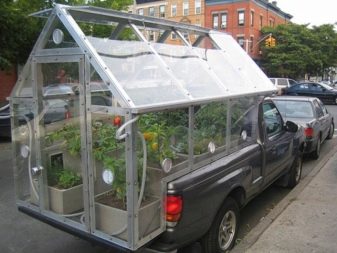
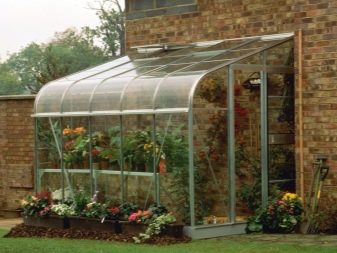
- An original design solution for the domed greenhouse.
- One of the unusual materials for building a greenhouse is plastic bottles.

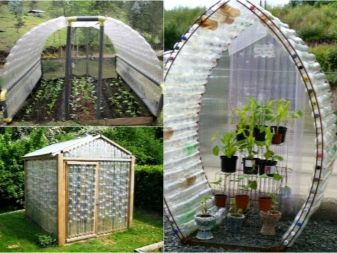
About the features of polycarbonate greenhouses, and how to choose the best greenhouse, see below.





























































The comment was sent successfully.